I’m going to explain how Labrador color genetics works and what the probabilities of different colored puppies are, with the help of some fun diagrams.
The Labrador comes in three main colors: black, chocolate, and yellow. These colors also come in few different shades. Some, like the red fox Lab, are achieved through selective breeding of those shades. Others through genetic differences like the controversial dilute gene.
Dilute genes make the typical Labrador Retriever colors paler, giving you charcoal, silver and champagne Labs. You can also find Labs with mismarks, for example, you might find a splash of white on the chest, paws or toes of otherwise solidly colored dogs.
- Pictures of the different Labrador colors
- Labrador Retriever colors through history
- Coat color genetics
- Predicting colors in a litter of puppies
- Rare Labrador colors
Today I’ll look at where the different colors come from, and what they mean for your dog’s personality, health, lifespan and temperament. I am going share pictures of all the different Labrador Retriever colors, and some I have some fun illustrations that help clear up the mystery of what happens when we mix the different colors together.
How Many Labrador Retriever Colors Are There?
Strictly speaking, there are only three different Labrador colors:
These are the three colors recognised and accepted by the AKC in the United States, and the Kennel Club in the United Kingdom. Personally I’m not a Lab color purist, but many Lab fans feel these should be the only registered colors in the breed. In practice, there are other colors available and there is a wide range of shades of yellow Labrador color, from palest cream to richest fox red.
Black Labrador
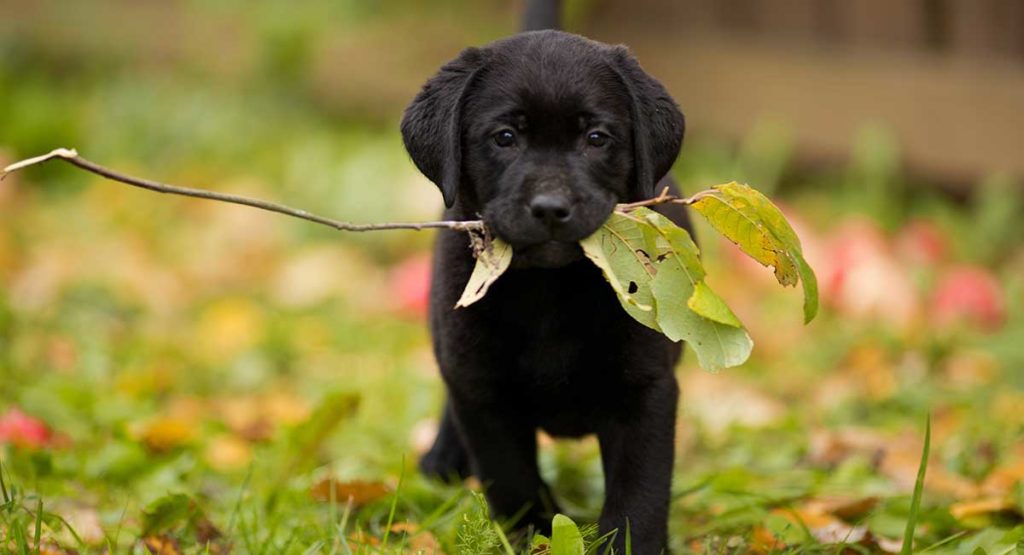
Chocolate Labrador
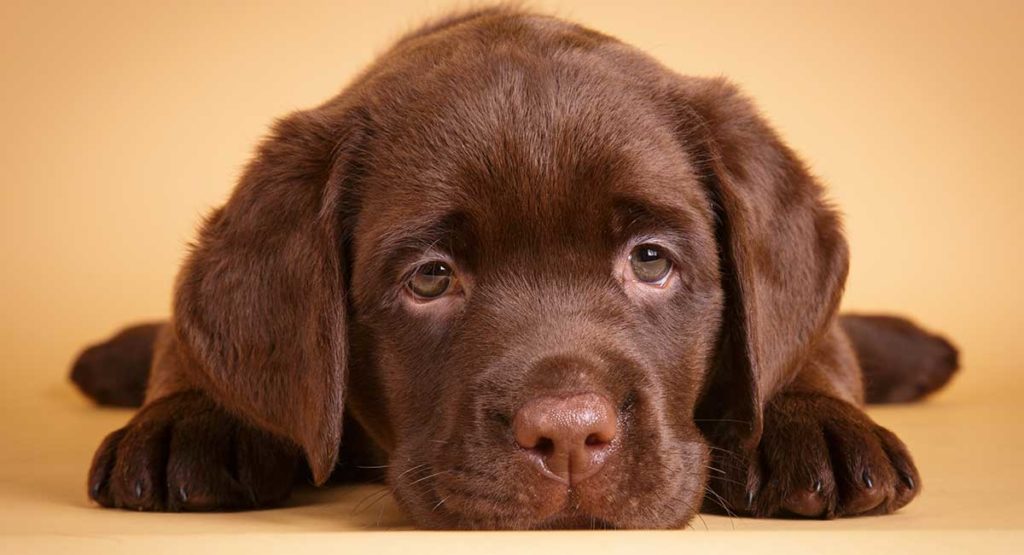
Yellow Labrador
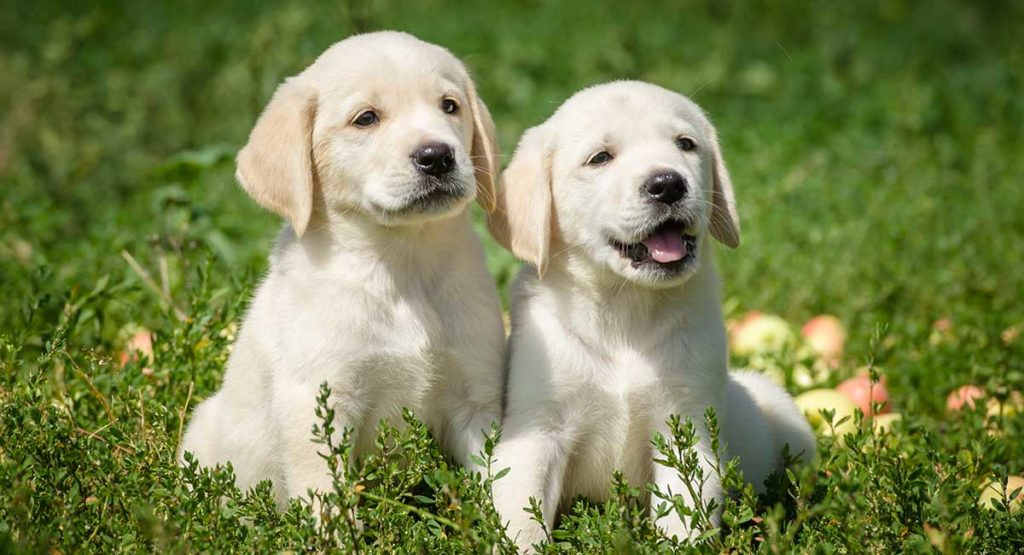
Red Fox Labrador
Silver Labrador
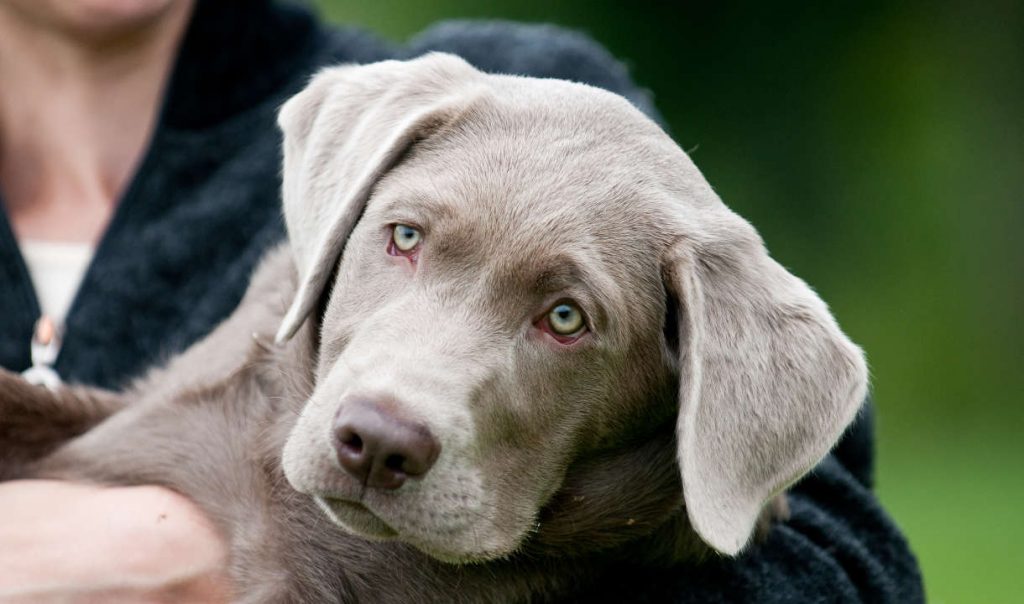
Champagne Labrador
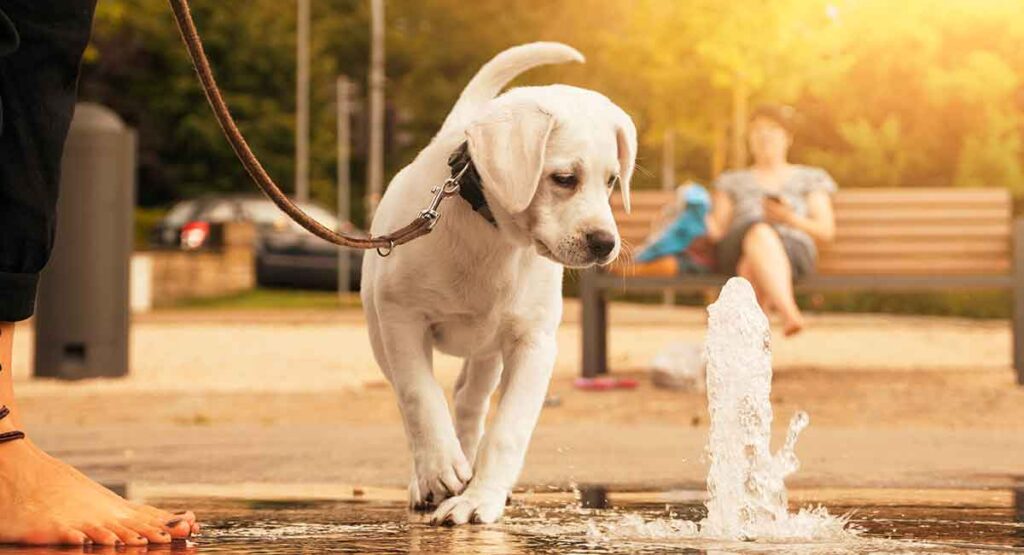
Charcoal Labrador
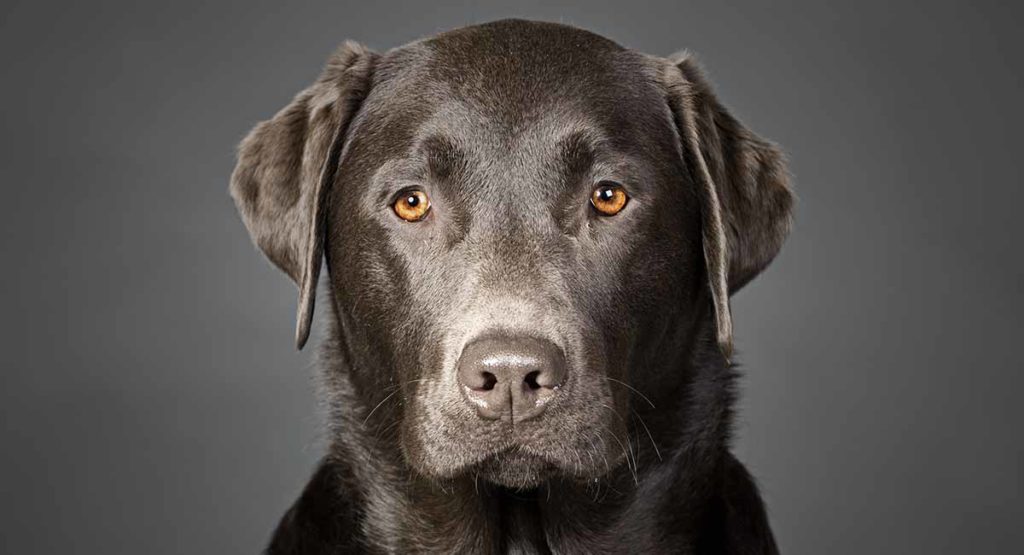
Know Your Lab Colors!
I’m going to explain the genetic code that controls Labrador color inheritance. And I’ll answer your questions about what puppy colors to expect when Labradors mate. My aim is to try to keep it as simple as I can! Understanding how a Labrador’s coat color is inherited starts with understanding how the three basic colors are passed on from one generation to the next. So I will tackle that first.
Original Labrador Retriever Color
Black is the original, archetypal Labrador color, and genetically the most dominant. In fact, from the breed’s inception in the early 19th century until the turn of the 20th century, it was the only acceptable color. Chocolate and yellow puppies were frequently euthanized at birth. So how come they didn’t die out altogether? To understand that we have to look at the genetic difference between black and chocolate Labs.

Labrador Retriever Color Genetics
Both types get their color from a pigment called eumelanin. Labs with lots of eumelanin pigment in their coat are black. If they have a little less, they appear brown instead. The genetic instruction for being black or brown is held at the B locus in a dog’s DNA. So what is a B locus?
“Locus” is just a fancy term for a specific location on a chromosome, that’s where we store the genetic code in every cell in our bodies. We use letters to tell each location apart – a bit like giving each locus its own zip code!
The B locus is home to a pair of genes called B genes. One of the pair comes from your Lab’s mom, and the other from their dad. There are two types of B gene your Lab can get in their pair:
- One we call big B – it contains an instruction to make lots of eumelanin, and causes a black Labrador coat.
- And one we call little b – it contains an instruction for less eumelanin, and causes a brown or chocolate coat.
Big B is a dominant gene, and little b is a recessive gene. Which leads us to…
Why Black is a Dominant Lab Color
The three different combinations of B genes that a Labrador can inherit from his parents are:
- BB
- Bb
- and bb.
Dominant genes override, recessive genes. I like to think of them as a switch that turn off the recessive gene they are paired with. So dog with BB genes will be black, because he has two genes for a black coat. And a Bb dog will be black too, because the dominant B genethe recessive b gene. Only a dog with a matching pair of bb genes will express the instruction for less eumelanin in their coat, and be brown.
How Chocolate Labradors Are Made
Here’s a handy table to help you picture that relationship between B gene combinations, and Lab coat color. Remember that the black dominant gene always switches of the brown gene, so only the dog with two copies of the b gene will actually look brown.

How Labrador Colors Skip Generations
Chocolate Labradors have grown steadily in popularity in recent years. But the dominance of the black color enabled our chocolate friends to remain hidden and rare with the breed, for many decades.
Generation after generation of black dogs can continue to have only black puppies if dogs with the Bb gene are only ever mated to dogs with BB genes. Let me show you how that looks:
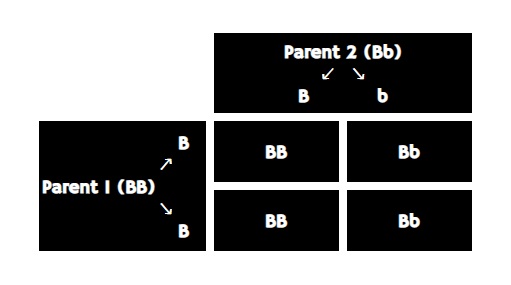
So you can see how the little b gene gets passed down through the generations without ever being expressed. In fact, it would take two black Labs both carrying the little b gene to produce chocolate puppies. Like this:
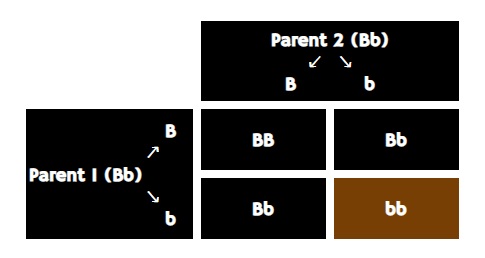
Statistically, one quarter of their litter would be chocolate colored. But like tossing a coin and getting heads several times in a row, it’s also possible for a Lab with Bb genes to pass the B version to every puppy in a litter, and only throw black puppies. And of course, some Labradors are neither black nor brown.
Where Do Yellow Labradors Come From?
There are times when a BB or a Bb dog is not black at all. And when a bb dog isn’t brown!
The genetic information that creates a yellow coat comes from another pair of genes altogether. These genes are located at the E locus. And – you guessed it – we call them E genes. Just like B genes there are two versions of the E gene, big E and little e.
- Big E is the dominant gene. It does not interfere with the B genes.
- Little e is the recessive gene. It has the potential to mask the B genes that would otherwise give us black or brown coats. And the result is a yellow dog.
How Yellow Overrides Black and Chocolate
Only the little e gene can mask the instructions for black or chocolate fur. But little e is recessive, and remember that ‘switch’ effect? If the dominant gene big E gene is present, the little e gene won’t work. There are three possible combinations of E gene that a dog can inherit. It could have
- two dominant genes (EE)
- two masking genes (ee)
- or one of each (Ee).
Only the middle of these three dogs will be yellow. In the first and third dog, the E gene will switch off the e gene, and the dog’s color will be determined by its B genes. Now let’s put all that information about B and E genes together!
Nine Different Possible Labrador Genotypes!
Every Labrador has a combination of B and E genes – called their genotype. There are nine different possible genotypes. Here they are in full:
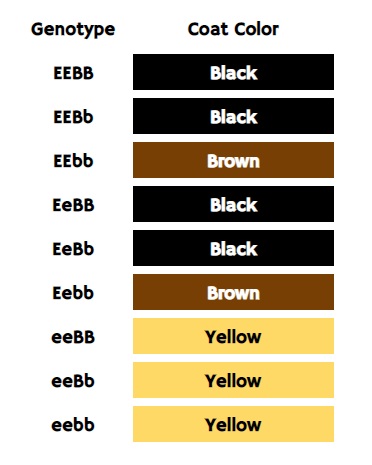
Can you see why each combination of genes turns out the way it does?
Predicting Labrador Retriever Colors in Puppies
Trying to work out what colors Labrador puppies will be is difficult without knowing the parents’ genotypes. Because as you can see, the second dog down the list may look black but he could throw brown puppies, and the fourth dog down the list may look black, but he could throw yellow puppies. The fifth dog down the list is also black but he could throw yellow and brown puppies. Puppy colors are easier to predict when both parents owe their appearance to the recessive genes b or e.
Mating Two Yellow Labradors
Two yellow Labradors mated together will never throw brown or black puppies. All their offspring will be yellow. This is because yellow dogs do not possess the big E gene which is needed to switch off the masking effect.
Mating Two Chocolate Labradors
Two brown Labs mated together will never throw black puppies because brown dogs do not have the big B gene. But two chocolate Labs can produce yellow puppies, if each of the parents carries the little e gene – like this:
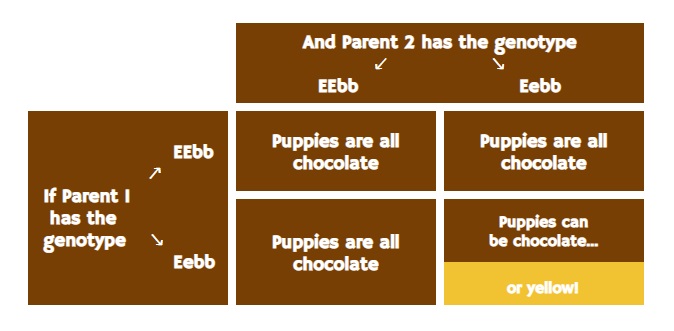
In the mixed litter, statistically one of half of the puppies will be chocolate and one half yellow. But just like tossing a coin, we know that the rules of probability aren’t the same as guarantees! That’s even more true when we start looking at other color combinations of parents. Let’s look at a few more examples
Can Two Black Labradors have Yellow or Chocolate Puppies?
Depending on their genotype, two black Labradors can indeed have yellow or chocolate puppies. Remember from our grid above that there are four different possible genotypes for a black Labrador. The genotype refers to the genetic code that the dog carries.
Four Ways to be Black
In the diagram below, I’ve put the four possible genotypes along the top to represent one parent – the mother for example. And the four different possible black genotypes down the side to represent the father. Inside the grid are the puppies that could be born from each combination.
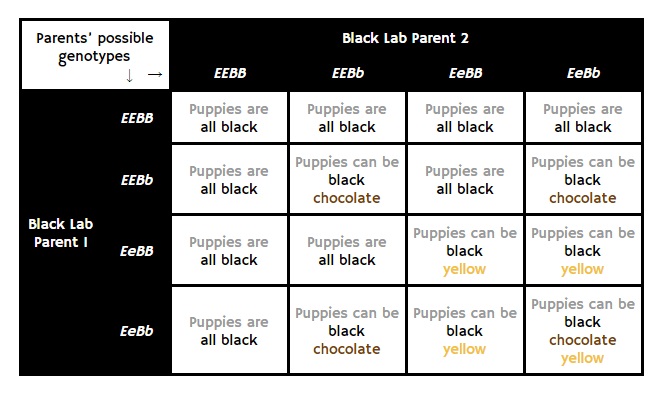
If and only if, both parents carry a little e gene, then some of the puppies may be yellow. Remember that your puppy needs two little e genes (one from each parent) in order to be yellow. If only one of two black dogs carries the little e gene, all their puppies will be black. But half will carry the yellow gene, and this is how the color can skip a generation
Is It Possible to Get All Three Colors from Two Black Dogs?
Yes it is, check out the bottom right hand square in the diagram above! Notice that it can only happen if both parents dogs have this genotype: EeBb. In other words, they both carry a little e and a little b.
Mating a Yellow Labrador with a Chocolate Labrador
Now let’s look at what color the pups will be if you mate a chocolate Lab with a yellow Lab. This is good example of how complicated, and unexpected, Labrador colors can be.
There are six different possibilities for litter color combinations depending on the genotype of the parents. You can even get a litter of all black puppies from a chocolate mother and a yellow father (or vice versa)! Here are the color possibilities:
- yellow, black, and chocolate puppies
- yellow and black puppies
- black and chocolate puppies
- yellow and chocolate puppies
- all puppies are chocolate
- all puppies are black
Let’s have a closer look and find out why. In this diagram I have put the yellow Labrador possible genotypes along the top, and the chocolate genotypes down the side.
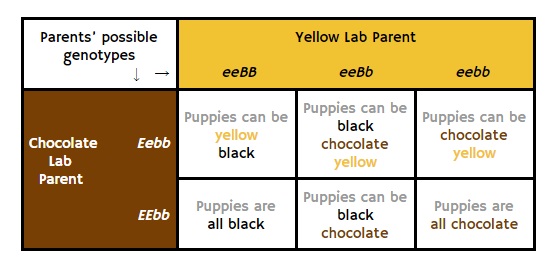
There are three ways to be yellow, and only two ways to be chocolate. A chocolate Labrador can be either Eebb or EEbb. That’s nice and simple. A yellow dog can be one of three different genotypes: eeBB, eebb, or eeBb – because every time two little e genes come together, they overwrite any combination of B genes. So, if a chocolate Lab with the genotype Eebb mates with a yellow Lab of the genotype eeBb, all the building blocks are there for puppies of every color. But if we mate EEbb with eeBB all the puppies will be black, because they will all have one big B and one big E.
Black Labradors Crossed with Chocolate Labradors
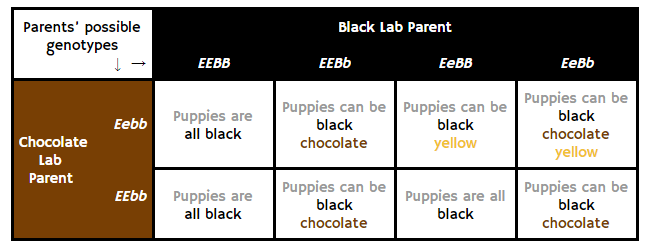
Let’s look now at what happens when we cross a black Labrador with a chocolate Labrador. We’ve seen that there are four different ways to be black, but that chocolate dogs only come in two different genotypes. That gives us 8 potential outcomes. The chart below has the different black Labrador genotypes along the top, and the chocolate genotypes down the side.
Finally, we’ll look at the last possible combination of standard Labrador colors. Black crossed with yellow.
Black Labs Crossed with Yellow Labradors
Because there are four ways to be black and three ways to be yellow, there are quite a variety of color pups for a mating between a black Labrador and a yellow Labrador.
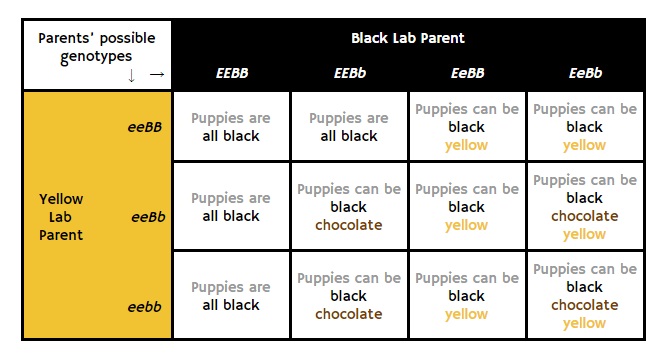
Of course, knowing what to expect depends upon knowing your sire and dams’ genotypes.
Some breeders might be able to hazard an educated guess based on observing several generations of litters.
But we’ve also seen how genes can remain concealed within a family tree for decades – so surprises are always possible!
And one of the biggest surprises of all for many breeders, is the silver Lab!
Silver Labradors
Last but not least, you may be wanting to know how silver Labradors get their coat color?
Silver is not among the traditionally recognised Labrador colors. Some of its detractors even believe it can only be possible if a Lab isn’t perfectly purebred at all.
But for lots of pet owners who don’t mind whether their Lab had a great, great, grandparent of a different breed, the possibility of an unusual and distinctive silver coat is rather special and appealing.
And that silver color comes from another pair of genes, which we haven’t looked at yet.
These are the Dilute genes.
Big D and little d.
The dilute genes have the potential to override all the other colors, albeit in a subtle way.
Labs have a pair of Dilute genes at the Dilute locus – DD, Dd or dd.
When two little d genes are paired together they dilute the coat color of the Labrador that carries them.
Silver Labs are chocolate labs with the dd genotype.
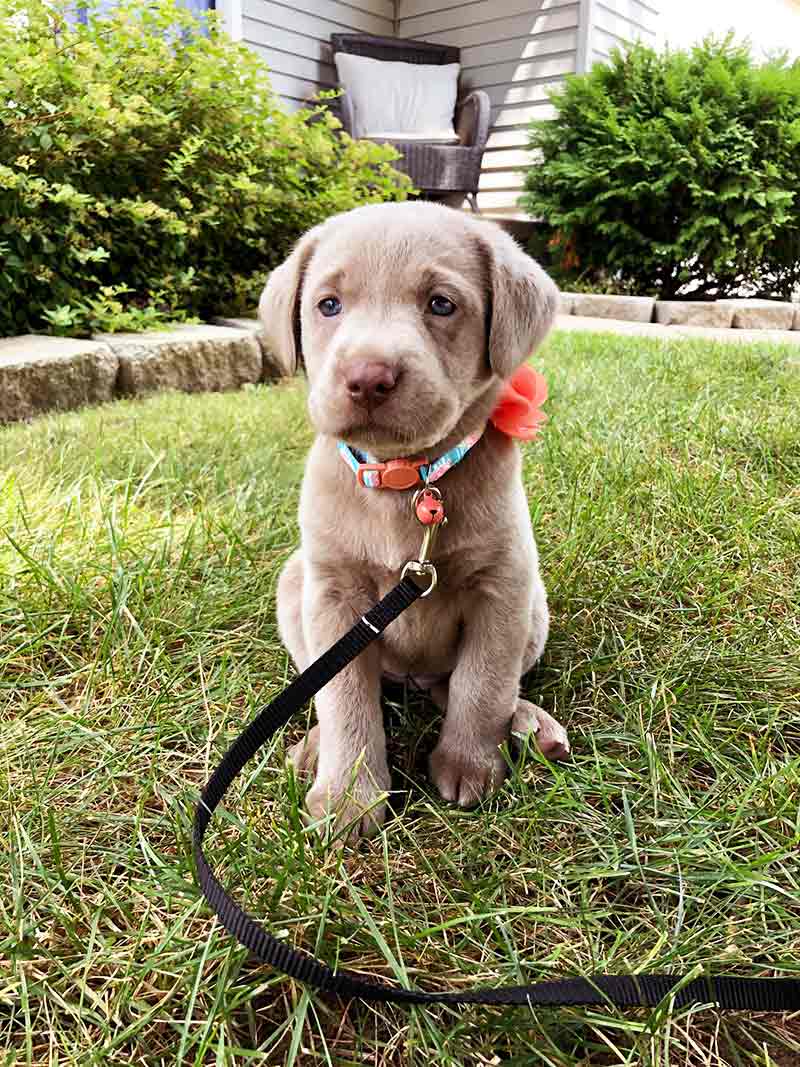
More Unusual Labrador Colors
The dd genotype dilutes the other Labrador colors as well.
In a black dog it gives a softer, charcoal coat color.
In a yellow dog a paler ‘champagne’ yellow.
Head over to our article on silver Labradors to find out more about why some Labs might carry the dilute gene, and what these unusual colors mean to Lab lovers.
Genetic Testing for Labrador Color Inheritance
For a lot of Labrador Retriever breeders, waiting to find out which Lab colors appear in their litter is part of the thrill.
But for breeders who prefer certainty over surprises, there are genetic tests to determine the genotypes of breeding dogs for the B, E and dilute genes.
Of course, knowing the genotype of your dogs doesn’t necessarily guarantee pups will be born in all the possible colors, or in statistically perfect proportions.
But they can give a valuable insight to, for example, a breeder specifically trying to avoid or achieve a silver Lab litter.
Rare Labrador Retriever Colors
If Labradors populations existed in the wild, we could expect chocolate to be the rarest Labrador color. That’s because of the nine possible E and B gene combinations, only two produce a chocolate coat.
But in the real world, Lab breeders have a degree of control over the color of puppies they produce, and they will be influenced by demand from dog owners.
Therefore, the frequency of each color in the Labrador population varies by region, and over time.
In the UK, black Labs are most closely associated with gundog work. But in the US, chocolate Labs have long been in demand as hunting dogs too.
And over time, more and more Labs have been reared purely for companionship. This means “novel” colors like silver and charcoal – previously considered unsuitable for working dogs – have gained their own fanbase.
So, the rarest Labrador color is subject to change over time, and difficult to keep track of.
Labrador Retriever Colors vs Intelligence
All Labs are intelligent and quick to learn new commands.
At the time of writing, we’re not aware of any research into the relative intelligence of Labrador colors.
In fact, it’s only in recent years that researchers have been satisfied that they can measure dogs’ intelligence in a reliable way.
This could be a valuable tool for assessing potential military working dogs and service dogs etc.
But it’s likely to be a while before we see it used to compared the intelligence of different color Labs.
In the meantime, you can find out why one Lab color has a reputation for being less smart than the rest over here.
Are Some Colors Better Than Others?
It isn’t unusual for people to be quite surprised by the color of the puppies in a litter that they have bred.
But as you can see, colors and indeed other inherited characteristics like certain diseases, can remain hidden from one generation to the next.
Potentially for many generations in a row if they are carried on a recessive gene.
It is enough to make your head spin!
But at the end of the day, beauty remains in the eye of the beholder, and your perfect Lab color won’t be the same as everyone else’s.
So which color do you like the most? And have you ever been surprised by an unexpected puppy color in a litter?
Tell us in the comments box!
If you want to refer back to any of the charts I have made for this article, you are welcome to do so providing you link to this website as the source.
References and Resources
- McGreevy et al, “Labrador retrievers under primary veterinary care in the UK: demography, mortality and disorders”, Canine Genetics and Epidemiology, 2018.
- University of California, Davis, “Genetic Diversity Testing for Labrador Retrievers”, 2018.
- Lofgren et al, “Management and personality in Labrador Retriever dogs”, Applied Animal Behavior Science, 2014.
- Everts et al, “Identification of a premature stop codon in the melanocyte‐stimulating hormone receptor gene (MC1R) in Labrador and Golden retrievers with yellow coat color”, Animal Genetics, 2002.
- Lazarowski et al, “Acquisition of a visual discrimination and reversal learning task by Labrador retrievers”, Animal Cognition, 2014.
The Labrador Site Founder
Pippa Mattinson is the best selling author of The Happy Puppy Handbook, the Labrador Handbook, Choosing The Perfect Puppy, and Total Recall.
She is also the founder of the Gundog Trust and the Dogsnet Online Training Program
Pippa's online training courses were launched in 2019 and you can find the latest course dates on the Dogsnet website

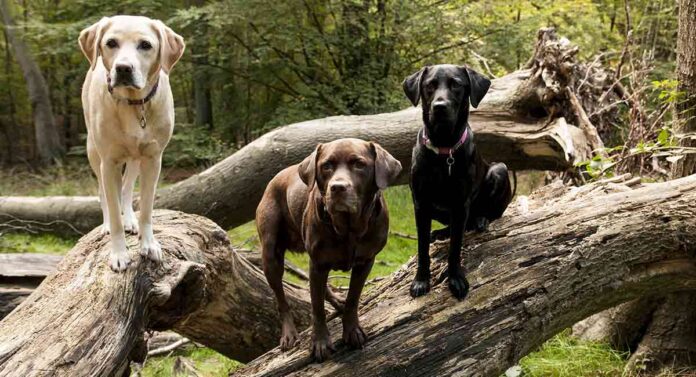
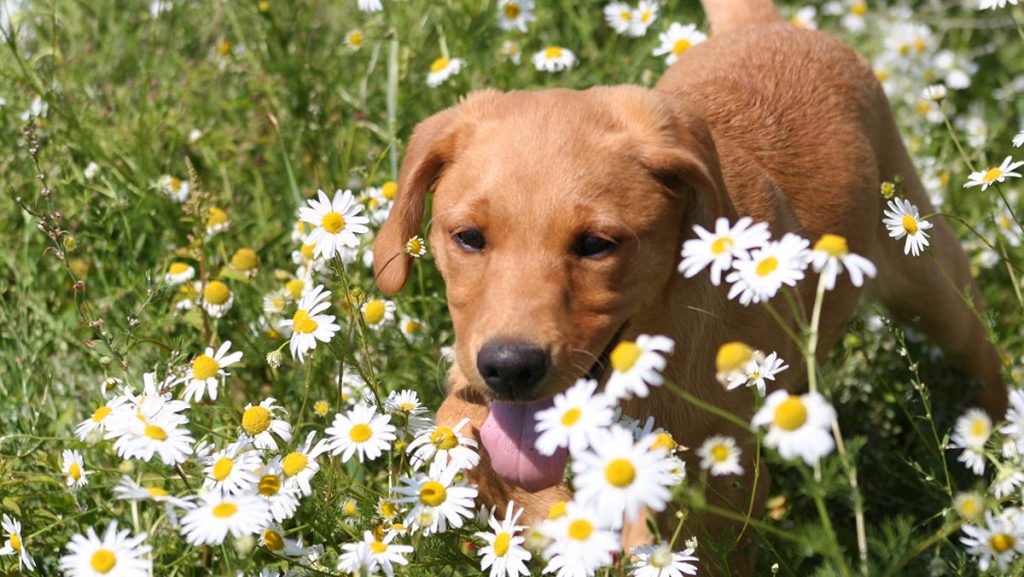
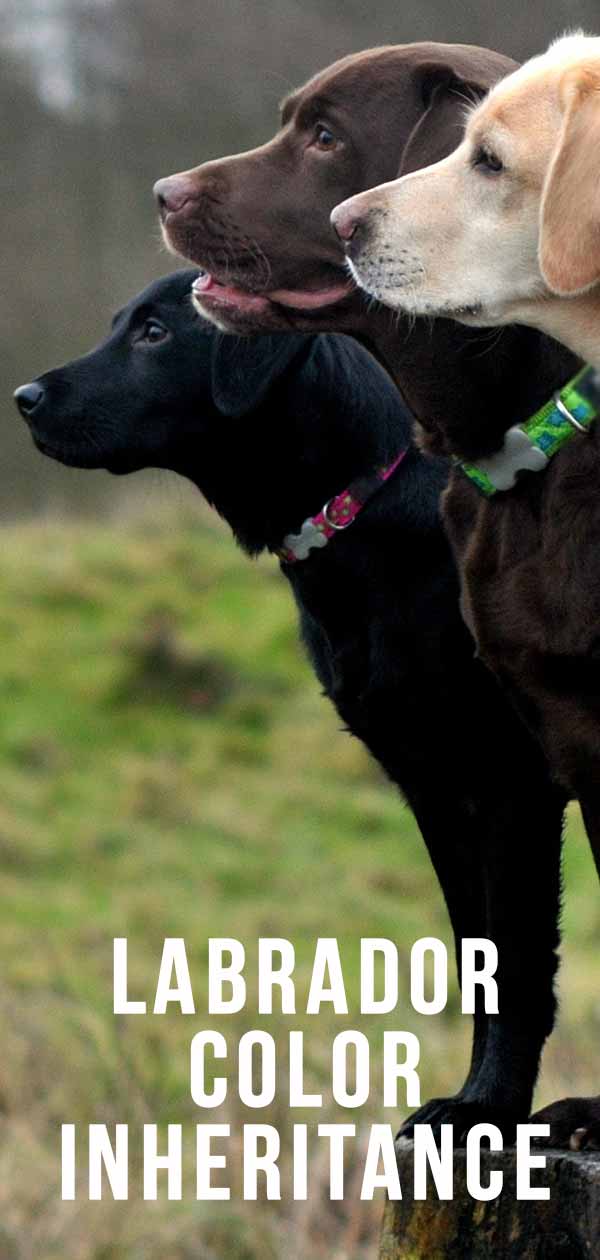








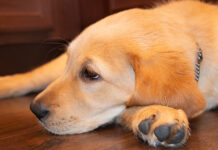









my akc paper lab is yellow and i bread her to a my akc black male . but she is having puppies now and i have got one that is brown but he has a mask ? i no she didnot get with anythinking . I am trying to figure out what color this puppy is . the rest of the litter looks like normal labs yellow and black . can some please help me ? thank you
We went to go see a litter of chocolate lab puppies, and saw 2 black ones in the litter of 7. We met mum, and she was a chocolate lab. I noticed that she was daintier than your typical lab, and didn’t have the “block head” that was common as well. She was beautiful though, and her temperament was amazing, I figured she was either a field lab or had a bit of mix, but it didn’t bother me… but looking back now, I should have asked. The reason being that we picked one of the black puppies who stole our hearts. Their father was supposedly an English chocolate, and we were shown a picture. We didn’t find out until after, that 2 chocolates cannot throw black, even though there were 2 in the litter, including ours. As he got older, it became clear that he wasn’t a pure lab, which is fine with me, but now I’m curious what his mix is. He is exceptionally handsome, has large webbed feet, a short corse coat (that is a little bit longer than your typical lab, with a wavy line down his back), but he doesn’t have the otter tail, it’s really long, his ears are really big, and he doesn’t have the “block head.” In fact, when most people see him they say “what a beautiful dog! What is he?” … then the other day, a woman said “oh! Is he a flatcoat retriever? My sister breeds them.” A quick google search, and I realized very likely what his mix is. His head is the spitting image of a flattie, except for the whisps of long hair. His ears are still exceptionally long, but I figure he will eventually grow into them. He’s longer and leaner than a lab too…more like the field lab, but closer in confirmation to the flattie. To make a long story short, we ordered a DNA test because we’re soooo curious! And also – wondering if there is ANY way possible his dad could have been the English chocolate we were told, or if its simply impossible…I assume the mum was the mix, but you never know! They could have bred her to two different dogs hoping she would catch and they just assumed because she had mostly chocolates, he was the father…
UPDATE – his DNA test confirmed that he was mostly lab, with about 20-25%% golden retriever in his lineage, and about 10% Airedale Terrier! This explains why his coat is black (mum was a chocolate), and why a lot of his features seem to be a tad “longer” than your typical lab. It is safe to assume that his father was not in fact the english chocolate, but rather likely a “Goldador.” The airedale terrier, I suspect came from his mother, though I could be wrong. He is absolutely fantastic, and we just love him to bits! Such a fabulous temperament and a really cool mix of breeds to boot!
I have black female labrador…I crossed her with yellow male labrador..first time got 5 puppys.3 pups are yellow. .Two of them was black… 2nd time I crossed that same male dog and we got 10 puppies. 7 pups are fully black and 3 of them are brown and black mix. Like a rottweiler dog. Still I don’t know what is the problem. Pls tell me anyone that.
What seems to be the problem? Looks to me like you have a pair of labs that throw all 3 colors which is perfectly fine. I have 2 blacks that throw all 3 colors. Nothing wrong with them, it’s all got to do with their genotype.
Just re-read your post. It’s a mutation of the genes sometimes. I’ve seen labs that look like a calico cat. It’s a different kind of mutated gene unlike the D gene.
Hi I breed my red fox lab with a cream color male lab will there puppies only be yellow ?
Hi I teach year 12 and 13 biology (and have a yellow lab). This article explains dihybrid inheritance far more succinctly than any of the A-level text books I have been making my students read- thank you so much, I will be giving them all the link!
From a personal viewpoint I would love to know more about the genetics of the different shades of yellow (so, I can see, would several other readers!) but I fear there are several more genes involved, especially in fox red, and my instinct tells me there may also be some sex linkage- are male fox reds more common than female? If you do have enough info for a follow up article I would imagine there would be a lot interest. Many thanks again for this excellent one.
Thank you, and I’m glad you found this helpful – shades of red are fascinating, we’ll definitely be looking at the topic at some point 🙂
How do you breed colour in Labrador Retrievers to whelp FOX RED / YELLOW LABS???
Hi George, Please see the section ‘predicting the color of Labrador puppies’ in the above article. Best wishes, Lucy.
Obviously not knowing the genotype of the parents it is indeed difficult to predict what colour the offspring will be, but are you aware of what genes are involved in creating the fox red shades of yellow and whether these are dominant or recessive? I wonder if it is a sex linked gene- perhaps making fox red makes more common than fox red females or whether the fox red is just recessive to yellow. I would love any further info you may be able to give on this. By the way, I have found this article to be extremely interesting and will recommend my high school biology pupils read this article when trying to understand dihybrid inheritance- you explain is much more succinctly than any of their text books do.
I have a 11 month old lab her mother was a white lab her father a black lab and now as shes shedding her winter coat we noticed shes turning grey ( she looks like she has grey socks) and a few areas on her back thats got grey is this normal for a lab that came from two different colored parents
I have a full blood lab pup that has brindle on her feet. How does this happen and will she grow out of the color?
My lab had white tuxedo markings and white paws and as he aged, his snout turned white, his litter had the Same markings, what part of the genetics determine the white marks?
I have a yellow lab puppy that as she gets older she is getting darker and darker. Her parents are both chocolate. Will she have the personally of a yellow lab or that of a chocolate lab. In reading some of your replies to questions I understand there is a color called red fox shade what personally do they normally have.
Found this article in trying to figure out why my black lab has brown “highlights” on her muzzle and legs. She is AKC registered. When I take her to the park everyone asks me what breed she is. I say lab and they reply back that she must be a mix. But she looks very lab to me. She is more of the smaller English Lab type. Any one have any thoughts?
I have a rescue dog with the exact same colouring that you are describing. A coworker of mine was telling me that her friend’s AKC registered lab had “off color” or “off mark” coloring which resulted in a brownish muzzle and legs. I came here looking for more info too.
If black female lab crossed with a yellow male lab. What are the possible colors expected.
Depends on genotype. U have a 4/12 chance of all black. 4/12 chance of black and yellow. 2/12 chance of chocolate and yellow. 2/12 chance of black, chocolate, and yellow. It all depends on their genotype. I have 3 breeder labs that I’ve figured out the genotype on just by breeding to each other and through stud services.
If u have bred before to other dogs and know what colors they had in litter, with enough thought, u can figure out their genotype.
what are the possible chances of getting puppies from a black mother and a yellow father
hi am sub
i have a chocolate lab mating with same color lab
and i am astonished and very happy also when i saw there are nine healthy puppy delivered with same chocolate color which is my favourite color
We have a white Lab, (English cream variety). It is like the Lab on Downton Abbey. We purchased from a breeder in Manitoba who specializes in this color. Does anyone else have a white Lab?
White is only a variation in the yellow color.
Hi. Great information. I read up on genes before because I have a black and tan lab. Her father was chocolate and her mother was black. She is definitely lab! I didn’t quite understand the full genetics of how she came out marked the way she did. Am I understanding it right when it says that both parents had a one in a rare gene for her to come out marked like that? If just one parent had the weird gene and the other didnt, she probably would had been a solid color? She is gorgeous and I get so tired of people saying she is a rottweiler or she is mixed. Thanks for any information. I can’t really find much on this topic.
Hey, great article, it helped me understand a lot. But I just had one question. My dog is a yellow Labrador with a pink nose. I heard its possible for them, pink-nosed, to produce chocolate lab puppies. BUT, she recently bred with another yellow lab and both of her parents are yellow. Is this still possible?
Hi Ashley, two yellow Labradors mated together will never throw brown or black puppies. All their offspring will be yellow. This is because yellow dogs do not possess the big E gene which is needed to switch off the masking effect 🙂 Have a look at the different possible combinations that can occur if you mate a yellow dog to a chocolate or black dog. It depends on the genotype of the dog.
If u breed yellow/yellow, u will only get yellow litter.
Just read your article. I have 2 labs. Female is yellow and the male is yellow. They bred (planned) and produced 1 black pup and 5 yellow. You say this is impossible but I kept accurate details of the breeding and never let my female out of sight even outside. I am not a breeder and only have the 2 dogs. Is it possible that your wrong? Both my labs have 1 black parent.
No Tiff, what you describe is not possible.:)
My chocolate lab has yellow feet. Have you ever seen anything like that?
Hi, just read your article. The breeder I bought my black lab puppy from gave me a registration paper that suggested his mother and father were both chocolate (his grandparents and great grandparents are also listed as brown). However is a black lab.. How is this possible? Did they lie?
Hey Hannah,
I’m a geneticist just doing some research for a friend that breeds Labradors. Just thought I’d answer your question while I was here. There is no way 2 chocolates can produce a black pup. It is never possible. One of your pups parents has to be Yellow or Black.
They did lie. Sorry:-(
2 chocolates will only produce chocolates or chocolate/yellow litters.
This article (and the site) was very educational, our five month chocolate lab came from a litter of three chocolate, three black and one yellow to black parents, now I understand how all three colours can exist in one litter.
Glad you found it helpful Steven 🙂
Hi I have a black labrador , whos parents were both black. She is 13 months old and just recently her coat has got in patches brown.. To be honest I thought at first it was mud , but we bathed her and its not mud. Any clue as to why this could be .
I have a silver (diluted chocolate) lab and I want to breed her eventually but I want to keep the diluted color going. It sounds like my best option is to breed her with a chocolate lab but I was wondering what the possibility of having diluted color puppies whether they’re black brown or yellow would be if I bred her with an English cream (diluted yellow) lab.
Hi Michaela, I’m going to add information about the way that the dilute gene is inherited in the next day or so. 🙂
Hi dear Pippa, first of all thank you for your book. All the advice works like a magic with our 11 weeks old pure bred chocolate lab. But few days ago I noticed his tail, like 2″ from the body, has a grey hair on it. Please, would you know what is wrong? We had a black lab and he never had this and this is a very big concern to me. he is only 10 weeks….Thank you. His mom was black and his dad was brown. all pups were brown. Thank you!!!
Hi there I have a few questions. We cam across a litter of pups whos mom is a chocolate and dad is yellow. 3 of the pups are solid black and 4 are solid white, there is one pup that came out broken colored like a brindle. Both the parents are registered. I have never seen this happen. Can you explain it? TIA
The yellow parent it either Bb or BB so carries black. You only need one B to be black so that is how they got black puppies….. the brindle I have no clue how that would happen.
Dear Pippa,
Your website is great and is very informative.
I just mate my female yellow lab with a chocolate lab and I have a litter of 4 yellow and 3 black pups. Is there any possibility for the next litter with the same chocolate lab to be or have chocolate pups? Greets from sunny Aruba 🙂
sir i read your article and congrats for that could you help me out with this situation.I got yellow lab and planned her to mate with black lab .What color type would i expect from her?Does she would produces all yellow or mixed colors of litters? any idea for me
Hi pippa my question is I have a male yellow that we just bred with a chocolate and she had all black pups, they are 2 weeks old now and two of them are starting to lighten up and look more chocolate. is it possible that they will be chocolate? thanks
Hi we are new lab owner we have a 3 month old lab. Read the site and was very educational.
My question is tjat the lab we have is blacb and ta
People always think its a German shepherd.
Mom was black and dad was chocolate is this a normal color for them
Thanks in advance
Cathy
I have a black female lab now crossed with a yellow male lab. What are the possible colors expected. Is there any chance of getting a lab with both color( mixed color lab)
It depends whether your black lab carries the gene for yellow. If she does then half the puppies could be yellow.
The Black and Tan is another set of gene’s altogether. the KB. They are a throw back to the beginning of the Labrador breed. A simple DNA test can be done to test for these markings.
So I have enjoyed this website. It has been super helpful. I have been a lab mom for about 15years and just recently had the first litter if our own. Both of ours are black and we ended up with 6 yellow and 2 black. This is super hard to explain to people that it can happen, most want to doubt they are full blooded. I am printing your artical to help explain this!! Thank you again!
Glad you are finding the site helpful Trish 🙂
When you cross a black lab who is half chocolate with a yellow lab who is half chocolate can you possibly get all three colors of lab pups?
Only if your Black lab also carries yellow. You should for sure get Black and Chocolate but you won’t get yellow unless the black dog is Ee that is carries a gene for yellow because a lab puppy must get a small e gene from each parent to be yellow.
Yes, the noses will start to turn black during the first few weeks.
We just had a litter with yellows. They have very pink noses. Will this charge to darker?
Hi Everyone, after reading a bit I think that what the Labrador site explained is that there are Three AKC registered colors for the Labrador Retriever Black, Chocolate (brown) and Yellow. Fox red is recognized by AKC in the Yellow family it is the darkest and then it goes to almost white. In America it seemed the lighter yellow was preferred. Then two very well know breeders went to England and brought back a fox red boy. They were both from Pennsylvania and has since moved there operations to other states. I also breed, and all of my studs are from one of those original breeders Keepsake Labradors. They are the most beautiful fox red color. I bred my Black girl to the only known living Fox Red Champion. My Black Girl had majority Black in her line but her Father was Yellow. I had a mixed litter of Black and Yellow the darkest yellow with red down her back and on her ears is the one I kept. I just bred her to a wonderful Fox Red Stud and she is due the end of march 2015. Can’t wait to see what colors she will have hoping for a black one like her Mother, but just can’t get away from that beautiful rich color of the fox red. So I’m hoping for both! Wish me luck!
Love it when Labbies and science meet. Thanks for a great explanation!
my female labrador dogs pregnancy period has exceeded, about 12 days over but not giving puppy, please tell me what i do for this
tell me what cautions i take for this problem.
And what about blue or lilac labradors ? I’m sure they inherit the blue gene from Weimaraners. Other colours like brindle, tan and black brindle and tan and little white markings on the other hand are colours that were in the Original population.
https://www.thelabradorsite.com/silver-labradors/ 🙂
there is chocolate ,black ,yellow, silver, fox red , and charcoal . how i now is cause i have silver chocolate yellow black and fox red.
I have 2 yellow almost red labs there brother and sister. They seem 2 be getting darker as the months pass is this normal? They habe an almost white mum and a black dad.
So I have a gold lab female and a chocolate lab male. Am I likely to get chocolate puppies from them? im assuming that my gold lab would have to have one or 2 BIG E genes for this to happen? I believe her siblings were all gold. However she has a chocolate colored nose. Is this an indication of her gene pool?
Hi I have recently bought what I thought was a lab 8weeks old she is mainly black with brown on her paws and legs and a slight bit of white on her chin does this,mean she is not a a lab or can this happen? I know the father was yellow and the mother chocolate labs. Any help please??
My black lab has pedigree papers. He is a black lab with 3 feet with white on bottom. Is he a purebred? We paid for a purebred. Still love Him regardless, but don’t understand.
Hi Lisa, We have a chocolate lab with a white blaze down his chest, this white fur comes from the very first breed of labrador that came from a new foundland dog, it had a white muzzle a white blaze and white feet.
Your dog can still be a full pure bred labrador with white on its coat.
I love you for this article because i am living in India where there is a lot street or local dogs which got this red colour. i bought a lab and its colour is red(which didn’t know when i buy it) then people here starts to tell that it is not a pure breed. But when i got into your site what i saw is exactly the same labs 🙂
Though vet said that mine is red colour i wasn’t confident enough. But when i saw your site i’m so glad 🙂
Is this a rare colour? because no one around in India saw this colour lab and this is the only site which i found this much pics of red labs
This is all very interesting. Believe me or not, a few years ago, we were given two labs that the owner called “blue labs”. A brother and sister, they were blue grey and had black all inside their mouths. The owner could not keep them and we had two small boys that these dogs played too rough with. We gave them to a friend, who said this color was really rare, and they were stolen from him shortly after we gave them to him. They were with out a doubt the most beautiful dogs I have ever seen, except my beloved German Shepherds !!!
these sound like charcoal labs to me
We have a pair of labs the male chocolate female yellow.We have had 4 litter now out of our female.Every litter has been 10 chocolate puppies.Ever heard of this? It seems very very rare to me.Any insight comments would be apreciated.
Yes I have a black female that has just bred with my chocolate male I was wondering the odds of what her puppies will look like
Hi Pippa, I have a male chocolate lab & a female yellow, they had the first litter & I was shocked. She had 1 black, three yellow & two brindle??? They have papers & a pedigree. The two brindle are very pronounced. Have you seen this happen before??
my chocolate (american field & trial) female just had her first litter on thursday. The sire is also a chocolate lab (english), and they are both from very reputable kennels. We have 6 chocs & 2 appearing black. Any explanation for this since it doesnt seem to match the gene determination?
Hi Susan
There are two possible explanations. The first is that your apparently black pups are very dark chocolate. The second is that a mis-mating has taken place.
Pippa
You could have a “B” genotype DNA test done for under $60 and see if it comes in “bb” or not. Since Choc. doesn’t have a “B” in it, the absence of a “bb” would mean the father of the blacks if not all the pups was not Chocolate.
Pippa, I have a chocolate female, that we were told carries the silver/charcoal gene, and also a fox red male. The first litter that we just had 2 days ago, were all chocolate. There are a few that are really lite that may be silver, but we did not get ANY yellow or fox red. Does this mean that every litter that they have together will be this way?
Hi Shauna, unless your chocolate dog carries the yellow gene she will not throw yellow puppies. If a good sized litter is all chocolate, that would suggest she probably is EE and does not carry the recessive yellow gene. However, all the puppies in the litter will carry the yellow gene because they each get a little ‘e’ from their yellow dad.
Pippa
I feel slightly aggrieved here as there is a “Forth” colour which is Fox Red and we also have one. This is in fact the “original” colour before the intense breeding bred it out to yellow or white. It is a beautiful colour and very distinctive. I am VERY surprised that the Labrador site does not know this! Enjoy your Fox Red Lab:) ( often gets mistaken for a Rhodesian Ridge back )
Hi Allan,
Fox red is considered a ‘shade’ of yellow, and fox red dogs have the same ee gene as other yellow dogs. The Kennel Club does not recognise it as a separate colour, and all fox red dogs are registered as yellow. Many of the photos on this site are of Fox Red labs and they are certainly very beautiful.
Pippa
Hi,
We viewed a litter of 8 yellow labs 6 and a half weeks of age. The one we chose has very blue eyes whereas 6 of them had brown eyes.
Is this common and are they likely to stay blue or will they become brown over time? Additionally she also has a brown nose instead of black.
I have been searching the internet but have struggled to find information about this.
Thank you
Hi Pippa – we have a 3 month chocolate lab who we got very sick from some unscrupulous breeders. Hopefully the wdorst is behind us and hes now grown into a playful, always hungry puppy.He hates to go for walks, is this normal? I’ve also noticed some black shades developing on his coat which is strange as otherwise he’s all chocolate coloured. Is this normal or is the black as I see it just a darker shade of chocolate? Still can’t pee train him but potty training is getting there. Thank you
Hi,
Chocolate can come in slightly different shades, and may change a little as the dog matures. A dog’s coat can also look rather patchy when he is moulting. Pippa
Hi
We have a labrador and he is red. We get a lot of comments on his colour as it seems to be quite rare, most people question his breed. Can you tell us how the red colour comes to be? Your article on colour is very interesting. Thankyou!
I feel slightly aggrieved here as there is a “Forth” colour which is Fox Red and we also have one. This is in fact the “original” colour before the intense breeding bred it out to yellow or white. It is a beautiful colour and very distinctive. I am VERY surprised that the Labrador site does not know this! Enjoy your Fox Red Lab:) ( often gets mistaken for a Rhodesian Ridge back )
It is just a color phase of the Yellow. It is a part in the DNA that is not fully understood yet.
Hi there, glad you like the site 🙂
All yellow dogs carry two little e genes and give one of these genes to every puppy in the litter. So every black puppy with a yellow parent will have a yellow gene to pass on to the next generation. Therefore you can expect a mixed litter
Whether you get the darker (fox red) shade of yellow is another matter, but good luck!